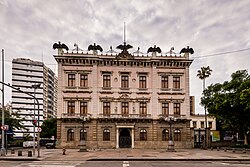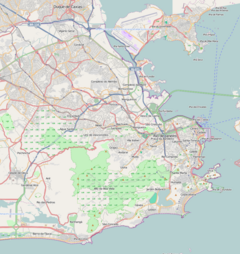You can help expand this article with text translated from the corresponding article in Portuguese. Click [show] for important translation instructions.
|
| Catete Palace | |
|---|---|
Palácio do Catete | |
 Former Presidential Palace; now Republic Museum | |
| General information | |
| Status | museum |
| Architectural style | Neoclassical |
| Location | Flamengo |
| Address | Rua do Catete, 153 |
| Town or city | Rio de Janeiro |
| Country | Brazil |
| Coordinates | 22°55′33″S 43°10′34″W / 22.92583°S 43.17611°W |
| Current tenants | Ministry of Culture (Museu da República) |
| Construction started | 1854 |
| Completed | 1867 |
| Renovated | 1883 |
| Client | António Clemente Pinto, Baron of Nova Friburgo |
| Owner | Brazilian government |
| Technical details | |
| Floor count | 3 |
| Design and construction | |
| Architect(s) | Carl Friedrich Gustav Waehneldt |
| Website | |
| museudarepublica.org.br | |
| Designated | 1938 |
| Reference no. | 153 |
The Catete Palace (Portuguese: Palácio do Catete, IPA: [paˈlasju du kaˈtetʃi]) is an urban mansion in the Flamengo neighborhood of Rio de Janeiro, Brazil. The property stretches from Rua do Catete (Catete Street) to Praia do Flamengo (Flamengo Beach). Construction began in 1858 and ended in 1867. It was Brazil's presidential palace from 1897 to 1960, and the site of Getúlio Vargas' suicide. It now houses the Museu da República (Republic Museum) and a theatre. The Catete underground rail station is adjacent.
